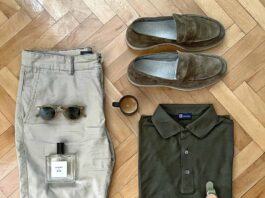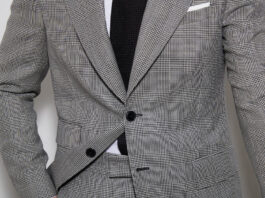

If you think glute workouts should be left to your belfie-obsessed better half, think again. Train the bum and you’ll reap rewards across the board, gaining strength, stability, and a strong base from which to build the rest of your workouts. Since they’re your biggest muscles, you’ll also burn more calories each and every day.
So why are you just sitting on them? To help you train your body’s best secret weapon, we asked some experts in the business to tell us exactly what you need to know to build the butt.
The Experts
David Wiener is a training and nutrition specialist at Freeletics
Chris Walton is a PT extraordinaire at Embody Fitness
Rueben Stone is a PT at Go Train Fitness
Keith McNiven is the founder of London-based personal training company Right Path Fitness
Why Do I Need To Train My Glutes?
Your glute muscles are some of the strongest and most powerful in the body, and training them is as important as training any other muscle. It’s especially important if you want to build your leg muscles.
They play a huge role for propelling us forwards (running, walking), upwards (climbing steps, jumping), sideways (stepping sideways during sports) and also helping to keep the body in an upright position. Much of the force required to propel Usain Bolt down the 100m track was generated by his glutes and even if your goals are much less ambitious than winning Olympic gold, don’t leave the behind behind.
“Training your glutes regularly can also help to combat and decrease the risk of lower back pain, and help you to build a strong core, supporting your muscles when you exercise and carry out everyday functional tasks,” says Wiener. “They can also improve your mobility and can improve your posture and athletic performance.”
Plus, having a strong body overall (which includes your glute muscles) lessens the risk of injury, especially in your knees, lower back and hamstrings.
“Glutes are very important because they support our pelvis and stabilize the hips,” agrees Stone. “The gluteus maximus also being the largest muscle in the body contributes to so many of our daily movements.”
And if fat loss is a goal and you aren’t working your glutes hard you are missing out on the potential calorie expenditure of the biggest muscle group in the body. So, big bum, big strong base to work from. Got it?
To help you get a clear picture of what part of the glute is working and when, we asked McNiven to break down the biomechanics of the bum: “The bottom is made up of three muscles,” he explains. “The main one is the gluteus maximus but there’s also the gluteus medius and the gluteus minimus. We tend to just call them ‘the glutes’. When you strengthen your glutes it can help your posture and balance, give you more power for your weight lifting and more mobility for your cardio work. If you want to build mass in your glutes though then you need to be training them with weights.”
Naturally, rushing off to the squat rack and loading the bar with stacks of 20kgs might not be the safest way to get started. In fact, when it comes to glutes, you need to train smarter, not harder, to avoid injury and maximize results. And make sure you look good in shorts come summer, of course.
The Best Glute Exercises For Building Mass
The barbell hip thrust is an important exercise if you’re aiming to build mass in the glute area. This is because it activates the upper and lower glutes more than any other exercise, and doing it properly can produce a deep burning sensation, really working the muscle group to add mass.
Barbell Hip Thrust
“To do this move properly,” Wiener advises, “place your upper back against a box or bench with your knees bent and your feet flat on the floor. Put a barbell with your desired weight across your hips so that your glutes edge towards the floor. Then, squeeze your glutes and raise your hips until they’re in line with your body and repeat.” 
Weighted Back Extensions
Lie face down on a hyperextension bench, tucking your ankles securely under the footpads. With your body straight, cross your arms in front of you or behind your head (hold a weight plate for extra resistance in front of you under your crossed arms).
Start bending forward slowly at the waist as far as you can while keeping your back straight until you feel a nice stretch on the hamstrings. Slowly raise your torso back to the initial position as you inhale. 
Shoulder Elevated Hip Bridges
Lie with your upper back resting on a bench and your feet flat on the floor in front of you, just wider than shoulder width apart. Keeping your back straight, raise your hips until your body forms a straight line from your shoulders to your knees. Squeeze your bum at the top. 
Squats
Stand up straight with a barbell across your shoulders, your feet shoulder-width apart. Lower yourself into the squat until your upper thighs are parallel to the floor. Stand up. 
Deadlifts
Stand up straight with your feet shoulder-width apart while holding a barbell at hip level. Keeping your shoulders back and your knees slightly bent, lower the bar by moving your butt back into a squat as far as you can. Keep the bar close to your body, and return to the starting position by driving the hips forward to stand up tall. 
Weight, Reps And Sets
“The important thing with glutes is to ensure you are working them hard enough,” says Walton. “They are used to pretty heavy loads, and if we want the body to change and adapt, the stimulus must be strong enough.”
This, ultimately, means exercises which require the glutes to go through a large range of motion as per above and also those where it’s possible to add external loads. But it’s also really important to ensure they are activated properly. This is where exercises like clam shells, lying glute bridges, banded walks and bird dogs come in.
“Once you’ve picked an appropriate exercise, it probably comes more down to the rep range you use as well as the speed you perform the contraction,” Walton explains. “Somewhere between 8-12 reps (3-4 sets) with a slow tempo on the lowering phase (3 seconds) would work pretty well for most people. Rest 60s between sets.”
The Best Accessory Exercises For Glutes
“These ‘accessory’ exercises won’t build glutes by themselves, but they may help to ensure the glutes are ‘firing’ when it comes to the heavier lifts,” explains Walton. In other words, do these as a warm-up before hitting the bigger exercises above.
Clam Shells
Lie on your side with your feet and hips stacked, your knees bent 90 degrees, and your head resting on your right arm. Draw your knees in toward your body until your feet are in line with your butt. Keeping your abs engaged and your feet together, raise your knee as far as you can without rotating your hip or lifting your right knee off the floor. Squeeze your glutes at the top of the move, before slowly lowering back down. Make it harder by looping a resistance band around both thighs, just above your knees. 
Lying Glute Bridges
Lie face up on the floor, with your knees bent and feet flat on the ground. Keep your arms at your side with your palms down. Lift your hips off the ground until your knees, hips and shoulders form a straight line. Hold for a couple of seconds before easing back down. 
Banded Walks
Position a resistance band around your lower legs, keeping the feet shoulder-width apart to maintain tension. With the band in place, keep your knees and hips slightly bent and the head and chest up. Staying low, take a slow, lateral step. Follow with the opposite leg. The resistance can be applied closer to the knees for an easier movement or around the ankles or feet for a more advanced movement. 
Bird Dogs
Begin on all fours with your hands directly under your shoulders and your knees directly under your hips. Pull your abs in to your spine. Keeping your back and pelvis still and stable, reach your right arm forward and left leg back. Don’t allow the pelvis to rock side to side as you move your leg behind you. Focus on not letting the rib cage sag toward the floor. Reach through your left heel to engage the muscles in the back of the leg and your butt. Return to the starting position, placing your hand and knee on the floor. Repeat on the opposite side. 
The Home Glute Workout
Can’t get to the gym? McNiven has you covered.
“You can train your glutes pretty easily at home with minimal kit,” he says. “Try a combination of clock squats, balance ball pulses and glute bridges.”
Clock Squats
“The idea of this exercise is to balance on one foot and squat as you move the other foot first forwards, then to the side, then back as if you’re pointing it to positions on a clock. First get your balance on your left foot, keeping this balanced leg slightly bent. Lift your right foot off the ground slightly then squat as you move it forwards to 12 o’clock and back to position.
Then do the same squatting as you move the right foot to 3 o’clock and back to position. Finally, squat as you move the right foot to 6 o’clock. Do 5 of these then repeat with the other leg to 12, 9 and 6 o’clock.” 
Balance Ball Pulses
“Balance or Swiss balls are brilliant for lifting and toning your glutes. Start by putting your tummy on the ball with your palms on the ground in front of the ball, knees gripping the ball at the other end. When you feel stable, lift one leg until it’s in line with your back then bend at the knee so your flat foot is pointing upwards. Flexing your glutes and using them to drive the motion, lift that raised leg even further for five pulses, so little movements of around 2-3 inches. Do three sets of these and then swap legs.” 
Glute Bridges
“Start by lying on your back on a mat, arms next to you with your palms facing downwards and your knees bent. Then you’re going to raise your bottom off the ground, really squeezing your glutes as you do so, until your chest, stomach and legs are all creating a perfect upwards straight line. Then slowly go back down. Repeat 10 times and do three sets in all.” 
How To Make Sure You’re Exercising Safely
As always, warm up, warm up, warm up! It’s always a good idea to warm up properly, and this means activating the nervous system so the correct muscles are doing the work. You also need to build up gradually, both in a session and over time, to heavier weights.
“It’s also important to do exercises you are capable of and have a good level of skill (and range) in,” says Walton. “Trying to squat heavy when you have poor hip mobility isn’t going to end well so you need to be sensible.”
McNiven recommends building the ‘pretzel stretch’ into your warm-up routine:
Lie back with your knees bent, then cross one leg over the other by resting the ankle of one leg against the knee of the other. Place your hands under the uncrossed leg and gently lift in towards you until you feel the stretch in your glutes. 












